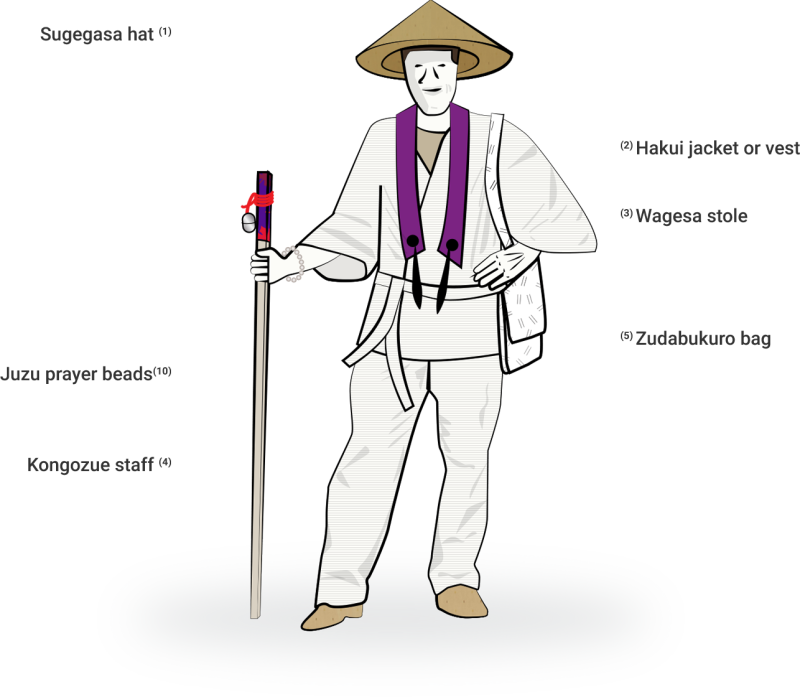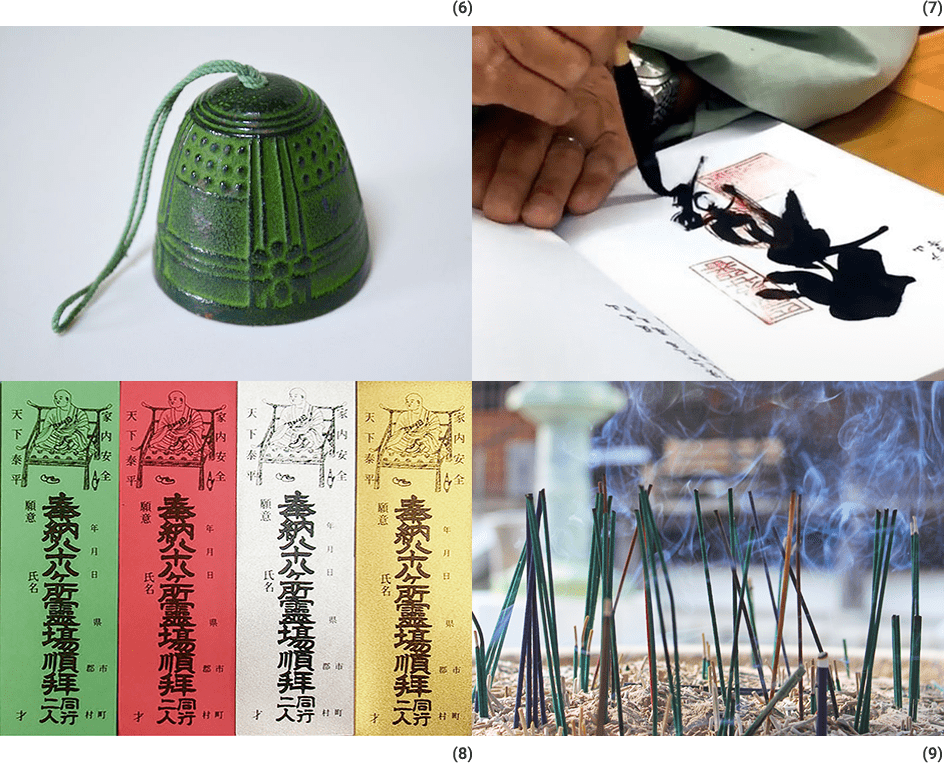Get Ready
Home » The Shikoku Pilgrimage » Get Ready
When you first conceive an intention to come to Shikoku and set foot on the Henro trail, you may suppose that the obstacles to becoming an Ohenro-san are rather high. Such is not the case. You can come just as you are and be a pilgrim. Or you can come and travel around the pilgrimage trail and not be a pilgrim. It’s up to you.
Today many pilgrims on the Shikoku Pilgrimage wear what might be called a pilgrim’s uniform, and a lot of people will tell you that it’s traditional. But that’s not really true.
Take for example the white clothing. We’re told that this represents a burial shroud in case the pilgrim dies on the journey. But the pilgrim’s clothing is different from a burial shroud, and in any case, the white clothing was first introduced by an enterprising bus company that sold its guests white vests to make them easier to herd around. In fact, old photographs show that pilgrims used to wear normal travel garb of whatever colour they fancied, with traditional straw sandals. But nobody thinks of wearing straw sandals today, however normal it used to be.
So in short, the pilgrim’s uniform can be considered a form of pious ‘cosplay’ (costume play), although it does have the benefit of identifying you as a pilgrim, and therefore eligible for the various kindnesses of ‘osettai‘. Osettai means gifts of food, drink, money, or other assistance provided by local people to pilgrims in the belief that good karma will accrue to the giver. Pilgrims who receive osettai are expected to pray on behalf of the giver at the next temple.
Here we take a look at the various items that make up the modern pilgrim look. You can buy these items at Temple No. 1 and near various other larger temples around the island.

SUGEGASA HAT (1)
These round, conical or domed hats were traditionally used by Japanese travellers of all kinds. They provide shade and a good airflow for protection against heat, and the better ones also shed water. Cheaper varieties require a plastic cover to keep rain off. The means of attaching them to your head may call for various accessories such as a bandana or towel for comfort.
On the sugegasa sold to pilgrims there are five lines of kanji written on the hat including the line “dogyo ninin“. There’s also a Sanskrit character for Kobo Daishi and the hat should be worn with this character at the front.
HAKUI JACKET OR VEST (2)
This white cotton vest is the most obvious marker of a pilgrim. The vests come with or without sleeves, and the cheapest ones are very flimsy. The more expensive jackets have Namu Daishi Henjo Kongo written on the back in kanji.
WAGESA STOLE (3)
This is the layman’s version of a priest’s stole (kesa) and it indicates that you’re engaged in Buddhist practice. The wagesa is a narrow scarf made of cotton or silk of various colours and designs. Originally, they were made from discarded material, so if you want to make your own and really stand out from the crowd, feel free.
KONGOZUE STAFF (4)
This walking stick is generally carried by all pilgrims. You can use any stick, but most people buy one ready-made. They can be plain, or adorned with writing such as Dogyo Ninin, and some have a brocade cover at the top. They may also have a small bell attached. This serves the dual purpose of scaring off wild animals on mountain trails, and bringing the pilgrim’s attention back to the present moment.
The kongozue represents Kobo Daishi and so it must be treated with respect. When you stop for the night, you must wash the bottom of the staff (washing the Daishi’s feet). If your room has a tokonoma, the staff should be kept there. If it becomes worn at the bottom, it shouldn’t whittled down with a knife. Also the staff mustn’t be used on bridges, since the Daishi was once obliged to sleep under one, and you might disturb him.
ZUDABUKURO BAG (5)
This bag is used for carrying your stamp book, incense, candles, osamefuda and other pilgrim’s sundries. It can be made of cotton or a more water-resistant plastic, with reinforced sections to protect the items inside.

JIREI BELL (6)
This large bell serves the same purpose as the smaller bell on your staff. It can be hung from your pack or somewhere convenient.
NOKYOCHO STAMP BOOK (7)
This is the book that you take to the nokyosho at each temple to receive the stamps and calligraphic flourish unique to the temple. It has sufficient pages for the whole pilgrimage, and becomes a thing of considerable value when filled with all 88 stamps.
OSAMEFUDA NAME SLIPS (8)
These slips of paper are a kind of calling card, and you can write your name and address on them and leave them at temples, or give them to people you meet. They can be offered to people as thanks for osettai.
INCENSE STICKS, CANDLES AND MATCHES (9)
These are lit in front of the main hall and Daishido of temples.
JUZU PRAYER BEADS (10)
These bracelets of beads were originally used for counting the number of repetitions of mantras or prostrations, but for most people now, they,re little more than an accessory.
Our Pilgrimage Tours

Experience the most beautiful and interesting temples of the Shikoku Pilgrimage in seven days.

A tour for families or friends, staying in the most characterful kominka and ryokan of Shikoku.

Visit the most beautiful and interesting temples of the Shikoku Pilgrimage and walk the toughest trails.
